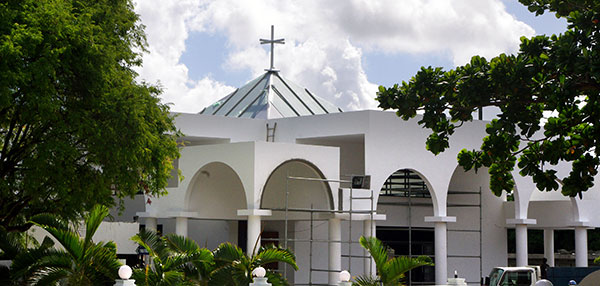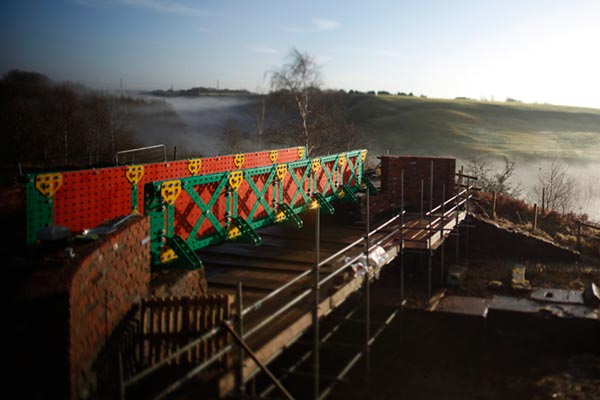Projects and Features
Protective coatings for structural steel

Spraying is the most commonly used method of applying paint to structural steelwork
Safeguarding structural steelwork with the correct corrosion protection system will give a steel frame a long life and reduce ongoing maintenance costs. NSC provides some key facts regarding the use and application of paint coatings and hot-dip galvanizing.
Paint systems for steel structures have developed over the years to comply with industrial environmental legislation and in response to demands from bridge and building owners for improved durability performance. Previous five and six coat systems have been replaced by typically three coat alternatives, and the latest formulations have focussed on application in even fewer numbers of coats, but with increasing individual film thickness.
Composition of paints and film formation
Paints are made by mixing and blending three main components:
- Pigments are finely ground inorganic or organic powders which provide colour, opacity, film cohesion and sometimes corrosion inhibition.
- Binders are usually resins or oils but can be inorganic compounds such as soluble silicates. The binder is the film forming component in the paint.
- Solvents are used to dissolve the binder and to facilitate application of the paint. Solvents are usually organic liquids or water.
Paints are applied to steel surfaces by many methods but in most cases this produces a ‘wet film’. The thickness of the ‘wet film’ can be measured, before the solvent evaporates, using a comb-gauge. As the solvent evaporates, film formation occurs, leaving the binder and pigments on the surface as a ‘dry film’. The thickness of the ‘dry film’ can be measured, usually with an electro-magnetic induction gauge. In general the corrosion protection afforded by a paint film is directly proportional to its dry film thickness.
A Paint System
Protective paint systems usually consist of primer, intermediate/build coats and finish coats. Each coating ‘layer’ in any protective system has a specific function, and the different types are applied in a particular sequence of primer followed by intermediate/build coats in the shop, and finally the finish coat (or top coat) either in the shop or on site.
- Primers are applied directly onto the cleaned steel surface, or in the case of duplex systems, the sealed metal coating, to wet the surface, to provide good adhesion for subsequently applied coats and to provide corrosion inhibition.
- Intermediate coats are applied to ‘build’ the total film thickness of the system. Generally, the thicker the coating the longer the life. Intermediate coats are specially designed to enhance the overall protection and, when highly pigmented, decrease permeability to oxygen and water. The incorporation of laminar pigments, such as micaceous iron oxide (MIO), reduces or delays moisture penetration in humid atmospheres and improves tensile strength. Modern specifications now include inert pigments such as glass flakes to act as laminar pigments. Undercoats must remain compatible with finishing coats when there are unavoidable delays in applying them.
- The finish coat provides the required appearance, the surface resistance of the system and the first line of defence against weather and sunlight, open exposure, and condensation.
- Stripe coats are additional coats of paint that are applied locally to welds, fasteners and external corners to build a satisfactory coating thickness at edges and corners where paint has a tendency to contract and thin upon drying.
The various superimposed coats within a painting system have to be compatible with one another so generally all paints within a system should be obtained from the same manufacturer and used in accordance with the manufacturer’s recommendations.
Application of paints
The method of application of paint systems and the conditions of application have a significant effect on the quality and durability of the coating. Standard methods used to apply paints to structural steelwork include application by brush, roller, conventional air spray and airless spray/electrostatic airless spray.
Airless spray has become the most commonly used method of applying paint coatings to structural steelwork under controlled shop conditions. Brush and roller application are more commonly used for site application, though spraying methods are also used. ‘Stripe’ coatings applied to edges and sharp corners are usually applied by brush.
The principal conditions that affect the application of paint coatings are temperature and humidity. These can be more easily controlled under shop conditions than on site.
- Air temperature and steel temperature affect solvent evaporation, brushing and spraying properties, drying and curing times and the pot life of two-pack materials, etc. Where heating is required, this should only be by indirect methods.
- Paints should not be applied when there is condensation present on the steel surface or the relative humidity of the atmosphere is such that it will affect the application or drying of the coating. Normal practice is to measure the steel temperature with a contact thermometer and to ensure that it is maintained at least 3°C above the dew point. However, moisture cured paints are available. These paints are specifically formulated for application in damp and humid conditions.

Galvanized steelwork was chosen for much of the M&S car park frame at Longbridge
Metallic Coatings
There are four commonly used methods of applying metal coating to steel surfaces. These are hot-dip galvanizing, thermal spraying, electroplating and sherardizing. The latter two processes are not used for structural steelwork but are used for fittings, fasteners and other small items. In this article NSC looks in more detail at the hot-dip galvanizing process.
Hot-dip galvanizing is a process that involves immersing the steel component to be coated in a bath of molten zinc (at about 450°C) after pickling and fluxing, and then withdrawing it. The immersed surfaces are uniformly coated with zinc alloy and zinc layers that form a metallurgical bond with the substrate. The resulting coating is durable, tough, abrasion resistant, and provides cathodic (sacrificial) protection to any small damaged areas where the steel substrate is exposed.
As the zinc solidifies, it usually assumes a crystalline metallic lustre, often referred to as spangling. The thickness of the galvanized coating is influenced by various factors including the size and thickness of the workpiece, the steel surface preparation, and the chemical composition of the steel. The typical minimum average coating thickness for structural steelwork is 85 µm. Thick steel parts and steels which have been abrasive blast cleaned tend to produce relatively thick coatings up to 140 µm.
Since hot-dip galvanizing is a dipping process, there is obviously some limitation on the size of components that can be galvanized. However, ‘double-dipping’ can often be used when the length or width of the workpiece exceeds the size of the bath. The longest tank in the UK is currently 21 metres in length, the maximum double-dip dimension is 28 metres, and the maximum lift weight is 16 tonnes.
Some aspects of the design of structural steel components need to take the galvanizing process into account, particularly with regards the ease of filling, venting and draining and the likelihood of distortion. To enable a satisfactory coating, suitable holes must be provided in hollow sections to allow access for the molten zinc, the venting of hot gases, and the subsequent draining of zinc. Further guidance on the design of articles to be hot-dip galvanized can be found in BS EN ISO 14713-1.
The suitability of steels for hot-dip galvanizing should also be considered. Structural steel that is to be hot-dip galvanized should be clearly specified, by invoking the appropriate options in the material standards, e.g. Option 5 in BS EN 10025-1.
Andrew Harrison, Sales & Marketing Director at Wedge Group Galvanizing says: “Hot dip galvanizing is highly sustainable, producing minimal waste, while the non-ferrous properties of the metal make it indefinitely recyclable without loss of physical or chemical properties.
“Galvanized products, once constructed or installed can also be removed, re-galvanized and re-used.”
Duplex coatings
For many applications, hot-dip galvanizing is used without further protection. However, to provide extra durability, or where there is a decorative requirement, paint coatings are applied. The combination of metal and paint coatings is usually referred to as a ‘duplex’ coating. When applying paints to galvanized coatings, special surface preparation treatments must be used to ensure good adhesion. These include light blast cleaning to roughen the surface and provide a mechanical key, and the application of special etch primers or ‘T’ wash, which is an acidified solution designed to react with the surface and provide a visual indication of effectiveness.
 Sponsors
Sponsors
Protective Coatings
Gold: Wedge Group Galvanizing
Silver: Jack Tighe Ltd
Bronze: Hempel; Jotun Paints; Joseph Ash Galvanizing; Sherwin-Williams













